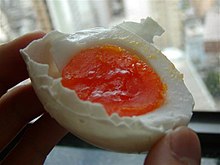| This article needs additional citations for verification. Please help improve this article by adding citations to reliable sources. Unsourced material may be challenged and removed. Find sources: "Salted duck egg" – news · newspapers · books · scholar · JSTOR (July 2011) (Learn how and when to remove this message) |
 | |
| Place of origin | China |
|---|---|
| Main ingredients | Duck egg in brine |
| Salted duck egg | |||||||||||||
|---|---|---|---|---|---|---|---|---|---|---|---|---|---|
| Chinese name | |||||||||||||
| Traditional Chinese | 1. 鹹鴨蛋 2. 鹹蛋 | ||||||||||||
| Simplified Chinese | 1. 咸鸭蛋 2. 咸蛋 | ||||||||||||
| Jyutping | 1. haam4 aap3 daan6 2. haam4 daan6 | ||||||||||||
| Hanyu Pinyin | 1. xiányādàn 2. xiándàn | ||||||||||||
| Literal meaning | 1. salted duck eggs 2. salted eggs | ||||||||||||
| |||||||||||||
| Alternative Chinese name | |||||||||||||
| Traditional Chinese | 鹹蛋 | ||||||||||||
| Simplified Chinese | 咸蛋 | ||||||||||||
| Literal meaning | salted eggs | ||||||||||||
| |||||||||||||
| Burmese name | |||||||||||||
| Burmese | ဆားဘဲဥ | ||||||||||||
| Vietnamese name | |||||||||||||
| Vietnamese | trứng vịt muối hột vịt muối | ||||||||||||
| Thai name | |||||||||||||
| Thai | ไข่เค็ม (khị khĕm; Literal meaning: salted egg) | ||||||||||||
| Malay name | |||||||||||||
| Malay | telur masin | ||||||||||||
| Indonesian name | |||||||||||||
| Indonesian | telur asin | ||||||||||||
| Filipino name | |||||||||||||
| Tagalog | itlog na maalat itlog na pula | ||||||||||||
| Khmer name | |||||||||||||
| Khmer | ពងទាប្រៃ | ||||||||||||
| Kapampangan name | |||||||||||||
| Kapampangan | ebun malat | ||||||||||||
| Cebuano name | |||||||||||||
| Cebuano | ginamos nga itlog | ||||||||||||
A salted duck egg is an East Asian preserved food product made by soaking duck eggs in brine or packing each egg in damp, salted charcoal. In Asian supermarkets across the Western world, these eggs are sometimes sold covered in a thick layer of salted charcoal paste. The eggs may also be sold with the salted paste removed, wrapped in plastic, and vacuum-packed. From the salt curing process, the salted duck eggs have a briny aroma, a gelatin-like egg white, and a firm-textured, round yolk that is bright orange-red.
Salted duck eggs are normally boiled or steamed before being peeled and eaten as a condiment to congee or cooked with other foods as a flavoring. The egg white has a sharp, salty taste. The orange-red yolk is rich, fatty, and less salty. The yolk is prized and is used in Chinese mooncakes to symbolize the moon.
Salted eggs can also be made from chicken eggs, though the taste and texture will be somewhat different, and the egg yolk will be less rich.
Salted eggs sold in the Philippines undergo a similar curing process, with some variation in ingredients used. They are dyed red (hence called itlog na pula or ‘red eggs' in English) to distinguish them from fresh duck eggs.
Production
Pateros method

A popular method for processing salted eggs in the Philippines is the Pateros method. The salted egg is prepared "Pateros style" by mixing clay (from ant hills or termite mounds), table salt, and water in a ratio of 1:1:2 until the mixture becomes smooth and forms a thick texture similar to the cake batter. The fresh, uncooked eggs are individually dipped in the admixture, and packed in 150-egg batches in newspaper-lined 250 mm × 300 mm × 460 mm (10 in × 12 in × 18 in) wooden boxes (often residual boxes of dried fish packing). The whole batch is then lightly wrapped in newspapers to slow down the dehydration process.
The eggs are then stored indoors at room temperature over the next 12 to 14 days to cure, the salt equilibrating in the batch by osmosis. Curing can last up to 18 days, resulting in very long-lasting red eggs that can have a 40-day shelf life, but this is largely unnecessary, as the eggs are stocked and replenished biweekly.
After the two-week curing period, the eggs are hand-cleaned with water and a brush and prepared to be boiled in low heat for 30 minutes. Time is measured from the first moment the water boils and the eggs are immersed. A 50-egg batch is then wrapped in fish nets for ease of removal from the cookware, which must be large enough to accommodate the batch with a 50 mm (2 in) covering of water.
Chicken eggs may be processed the same way, although up to 10% of the batch can break during the process.
See also
References
- Sandra Leong, 2008. Salted egg hunt, Mar 23, 2008, The Sunday Times